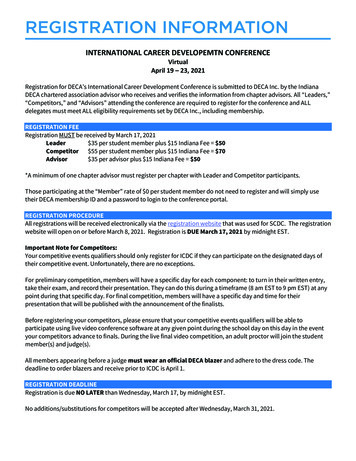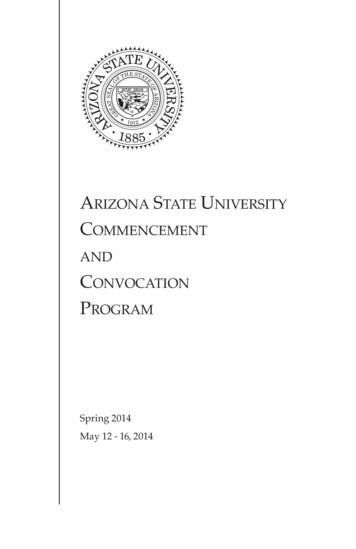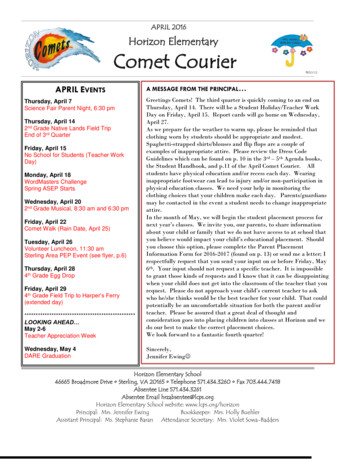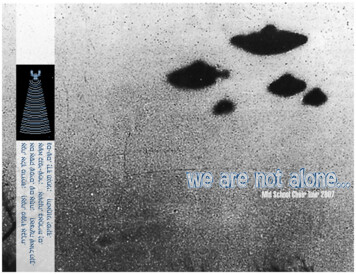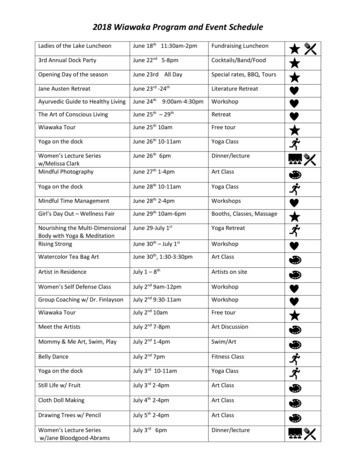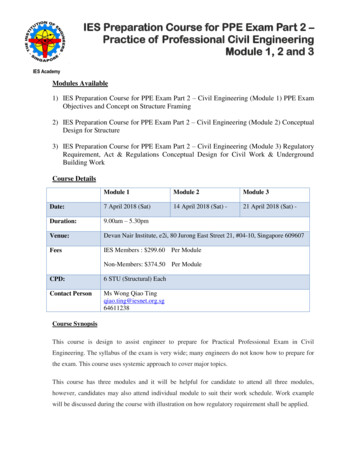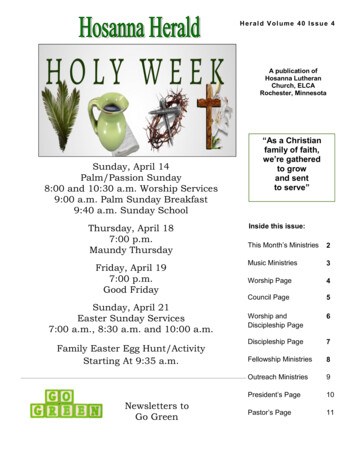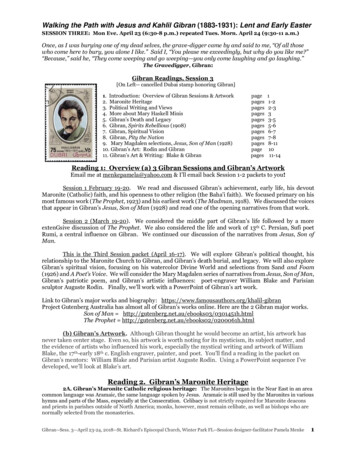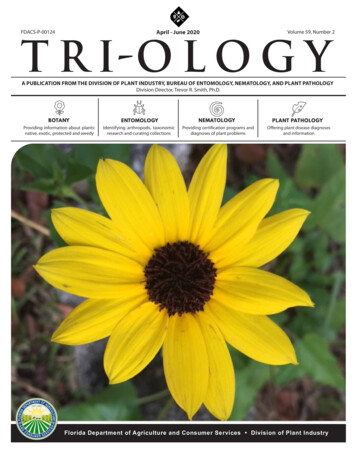
Transcription
T R I-O L O G YApril - June 2020FDACS-P-00124Volume 59, Number 2A PUBLICATION FROM THE DIVISION OF PLANT INDUSTRY, BUREAU OF ENTOMOLOGY, NEMATOLOGY, AND PLANT PATHOLOGYDivision Director, Trevor R. Smith, Ph.D.BOTANYENTOMOLOGYNEMATOLOGYPLANT PATHOLOGYProviding information about plants:native, exotic, protected and weedyIdentifying arthropods, taxonomicresearch and curating collectionsProviding certification programs anddiagnoses of plant problemsOffering plant disease diagnosesand informationFlorida Department of Agriculture and Consumer Services Division of Plant Industry1
Phaenomerus foveipennis (Morimoto), a conoderine weevil.Photo by Kyle E. Schnepp, DPIABOUT TRI-OLOGYThe Florida Department of Agriculture and Consumer ServicesDivision of Plant Industry’s (FDACS-DPI) Bureau of Entomology,Nematology, and Plant Pathology (ENPP), including the BotanySection, produces TRI-OLOGY four times a year, covering threemonths of activity in each issue.The report includes detection activities from nursery plantinspections, routine and emergency program surveys, andrequests for identification of plants and pests from the public.Samples are also occasionally sent from other states or countriesfor identification or diagnosis.HOW TO CITE TRI-OLOGYSection Editor. Year. Section Name. P.J. Anderson and G.S. Hodges(Editors). TRI-OLOGY Volume (number): page. [Date you accessed site.]For example: S.E. Halbert. 2015. Entomology Section. P.J. Andersonand G.S. Hodges (Editors). TRI-OLOGY 54(4): 9. [Accessed 5 June 2016.]Copies of TRI-OLOGY are kept on the FDACS website for twoyears. To obtain older copies, contact the FDACS-DPI Library at(352) 395-4722 or PlantIndustry@FDACS.gov.TABLE OF CONTENTS03HIGHLIGHTSNoteworthy examples from the diagnostic groupsthroughout the ENPP Bureau.04BOTANYQuarterly activity reports from Botany and selectedplant identification samples.07ENTOMOLOGYQuarterly activity reports from Entomology and samplesreported as new introductions or interceptions.11NEMATOLOGYQuarterly activity reports from Nematology anddescriptions of nematodes of special interest.ACKNOWLEDGEMENTSThe editors would like to acknowledge the work of all those whocontributed information and explanations by providing data,photographs or text, and by carefully reading early drafts.14PLANT PATHOLOGYQuarterly activity reports from Plant Pathology andselected identified plant pest and disease samples.We welcome your suggestions for improvement of TRI-OLOGY.Please feel free to contact the helpline with your comments at1-888-397-1517.Thank you,Gregory Hodges, Ph.D.EditorAssistant Director, Division of Plant IndustryPatti J. Anderson, Ph.D.Managing EditorBotanist, Division of Plant Industry2Cover PhotoHelianthus debilis (dune sunflower) summer wildflowerPhoto by Patti Anderson, DPI
HIGHLIGHTSdodecaneura Vell. (ornamental yam;1 Dioscoreavariegated monkey ball) is native across South Americafrom Guyana in the north to Paraguay in the south and wasfirst described from collections in Brazil. In Florida, this yam hasescaped cultivation in Leon County, and now for the first time isreported in Alachua County where it was found in the HogtownCreek Headwaters Nature Park.karachiensis Anwarullah & Khan, a2 Terminalichusnew Western Hemisphere record for a flat mite. Thismite, known to feed only on Terminalia catappa (West Indianalmond), was described from Pakistan. Terminalichus comprisesa rare genus of only seven species. There is no evidence any ofthese species, native to South Asia, are pests.1 - Dioscorea dodecaneura (ornamental yam), multicolored leaves.Photo by Patti Anderson, DPIjavanica (Treub, 1885) Chitwood, 1949,3 Meloidogynethe Javanese root-knot nematode, and M. arenaria (Neals,1889) Chitwood, 1949, the peanut root-knot nematode, werefound infecting and reproducing in roots of the woolly-leafwhite sapote, Casimiroa tetrameria Millsp., and the curry leaftree, Murraya koenigii (L.) Sprengel, two new host records.These nematodes were found during a survey in the arboretumof the Florida Department of Agriculture and ConsumerServices, Division of Plant Industry, a collection including 36species of Rutaceae, along with their hybrids and cultivars.2 - Terminalichus karachiensis Anwarullah & Khan.Photo by Samuel Bolton, DPISeptoria sp. (fungal leaf spot), a new host record, was4submitted on a cultivar of Cannabis sativa L. (hemp) from anursery. Symptoms of this disease appear as brown, irregularlyshaped spots with a yellow margin (halo). Lower leaves withinthe inner canopy are infected first because high humidity, leafmoisture and low air circulation found there are the conditionsunder which this fungus thrives.3 - Murraya koenigii (curry leaf) new host of the Javanese root-knot nematode(Meloidogyne javanica) and the peanut root-knot nematode (M. arenaria).Photo by Randall Dean, DPI4 - Septoria sp. symptoms (brown leaf spots with yellow halo on lower leaves)on a hemp cultivar of Cannabis sativa.Photo by Mark Terrell, DPI3
BOTANYCompiled by Patti J. Anderson, Ph.D. and Alex de la Paz, B.S.This section identifies plants for the Division of PlantIndustry, as well as for other governmental agencies andprivate individuals. The Botany Section maintains a referenceherbarium with over 14,000 plant specimens and 1,400 vialsof seeds.QUARTERLY ACTIVITY REPORTAPRIL - JUNESamples Submittedby Other DPI SectionsSamples Submittedfor BotanicalIdentification OnlyTotal SamplesSubmittedSpecimens Added tothe Herbarium2020 - YEARTO DATE1,1512,2891052641,2562,5531213471a - Dioscorea dodecaneura (ornamental yam), multicolored leaves.Photo by Patti Anderson, DPISome of the samples submitted recently are described below.dodecaneura Vell. (ornamental yam;1 Dioscoreavariegated monkey ball), from a genus of over 600species native to tropical and warm regions, in the plant familyDioscoreaceae. This species is native across South Americafrom Guyana in the north to Paraguay in the south and wasfirst described from collections in Brazil. In Florida, this yamhas escaped cultivation in Leon County and now is reportedin Alachua County where it was found in the Hogtown CreekHeadwaters Nature Park. The vine grows from an edible,tuberous, underground stem, twining counter-clockwise to alength of up to 4 m, usually dying back in winter except in thewarmest climates. Leaves of this ornamental yam are alternateand roughly heart-shaped but quite eye-catching in color. Theupper leaf blade surfaces are variegated dark and light greensmarked with silvery veins while the lower surfaces vary fromdark maroon to pinkish purple. Although the separate male(staminate) and female (pistillate) whitish-green flowers areinconspicuous, the fruits produce viable seeds. The plant canbe grown indoors in cooler climates as an attractive foliageplant, while in warm regions (USDA zones 9-11) it can growoutdoors. Although it is likely to lose its leaves in winter, theyreturn as the vine begins to regrow from the tuber in spring.This species has been known as D. discolor (meaning twodistinct colors) in the past, and older references might use thatsynonym. (Mabberley 2017; Cullen et al. 2011; r/PlantFinderDetails.aspx?taxonid 279849&isprofile 0& [accessed 22 June2020]; pni.org:names:323912-2 [accessed 22 June 2020];41b - Dioscorea dodecaneura (ornamental yam), underside of multicolored leaves.Photo by Patti Anderson, DPI
https://toptropicals.com/catalog/uid/Dioscorea dodecaneura.htm [accessed 22 June 2020].)dalenii Van Geel (African gladiolus), from a2 Gladiolusgenus of about 260 species native to Africa, Madagascarand Eurasia, in the plant family Iridaceae. The center ofdiversity for this genus is in Africa, but it is widely cultivatedand introduced globally. This species was named by PierreCorneille Van Geel in 1828 to honor the Dutch botanistCornelius Dalen, who was the Director at Rotterdam BotanicGardens. Ranging from eastern South Africa and Madagascarthroughout tropical Africa and into western Arabia, this isone of the most widely distributed species of Gladiolus. It wasintroduced in the United States as an ornamental in gardensand landscapes but sometimes escapes and persists outsidecultivation in Alabama, Florida, Louisiana and Mississippi. InFlorida, it is found in disturbed sites in the central peninsulaand panhandle. The sample submitted for identification thisreporting period is a new county record for Hernando County.These perennial herbs grow from corms and can reach up to 2m in height. The stems are erect and unbranched. Each planthas four to seven distichous leaves, both basal and along thestem. The leaf blade is narrowly lanceolate, parallel-veined andflat. Inflorescences are spicate with 2-14 secund to distichousflowers each subtended by two leaf-like bracts. Flowers consistof six tepals (in two whorls of three), three stamens and aninferior ovary with a three-branched style. The tepals are redto orange with yellow markings and are fused at the base intoa distinctly curved tube. Fruits are broadly ellipsoid capsulesdivided into three compartments (three-locular) that split opento expose many broadly winged, glossy, light brown seeds(rarely a few are wingless). Flowering and fruiting occur fromspring through summer. Hybrid strains of Gladiolus are widelycultivated as ornamentals around the world. This species hasundergone crossing and subsequent selection to generatemost of the popular ornamental hybrids used today. (HernandoCounty; B2020-160; Nora Marquez; 1 April 2020.) (Goldblatt2002; Weakley 2015; Wunderlin and Hansen ?id 487 [accessed29 June 2020]).2a - Gladiolus dalenii Van Geel (African gladiolus), whole plantPhoto by Chelsie Vandaveer, Atlas of Florida PlantsREFERENCESCullen, J., Knees. S.G. and Cubey, H.S., eds. (2011). TheEuropean garden flora, flowering plants: a manual for theidentification of plants cultivated in Europe, both out-ofdoors and under glass, 2nd edition. Volume 1. CambridgeUniversity Press, New York, New York. 665 p.Goldblatt, P. (2002). Gladiolus. In Flora of North AmericaEditorial Committee, eds. 1993 . Flora of North AmericaNorth of Mexico. 19 vols. New York and Oxford. Vol. 26, pp.407-409.Mabberley, D.J. (2017). Mabberley’s plant-book: a portabledictionary of plants, their classification and uses, 4th edition.Cambridge University Press, New York, New York. 1,102 p.Weakley, A. S. (2015). Flora of the southern and mid-Atlanticstates. Working draft of 21 May 2015. University of NorthCarolina Herbarium, North Carolina Botanical Garden,University of North Carolina, Chapel Hill. 204 p.Wunderlin, R.P. and Hansen, B.F. (2011). Guide to thevascular plants of Florida, 3rd edition. University Press ofFlorida, Gainesville, Florida. 783 p.52b - Gladiolus dalenii Van Geel (African gladiolus), flowerPhoto by Roger Hammer, Atlas of Florida Plants
BOTANY IDENTIFICATION TABLEThe following table provides information about new county records submitted in the current volume’s time period. The table isorganized by collection date in descending chronological order. The full version with more complete data is downloadable as aPDF or an Excel spreadsheet organized by collector name, except new county records are listed first.NEWRECORD6COLLECTOR NAMECOUNTYSAMPLENUMBERCOLLECTIONDATEPLANT NAMEFelipe N. Soto-Adames, Julieta BrambilaAlachuaB2020-2316/7/2020Dioscorea dodecaneuraNora V. MarquezHernandoB2020-1604/1/2020Gladiolus dalenii
ENTOMOLOGYCompiled by Susan E. Halbert, Ph.D.This section provides the division’s plant protection specialists and other customers with accurate identifications of arthropods.The entomology section also builds and maintains the arthropod reference and research collection (the Florida State Collectionof Arthropods with over 10 million specimens) and investigates the biology, biological control and taxonomy of arthropods.QUARTERLY ACTIVITY REPORTAPRIL - JUNE2020 - YEARTO DATESamples Submitted1,2502,516Lots Identified2,8155,58526,03453,855Specimens Identifiedkarachiensis Anwarullah & Khan, a1 Terminalichusnew Western Hemisphere record for a flat mite. Thismite, known to feed only on Terminalia catappa (West Indianalmond), was described from Pakistan. Terminalichus is arare genus of only seven species, all feeding on plants in thefamilies Combretaceae and Myrtaceae. There is no evidenceany of these species, native to South Asia, are pests. This newrecord of T. karachiensis, based on a single adult female, isclearly the result of the shipment of the host plant, Terminaliacatappa, to Florida. Because T. karachiensis is a rare and smallmite (body length 0.25 mm) and causes no discernibledamage or symptoms, it readily evaded detection until thisnew record. (Miami-Dade County; E2020-1616; Lis SantosPiloto; 23 April 2020.) (Dr. Samuel Bolton.)1 - Terminalichus karachiensis Anwarullah & Khan.Photo by Samuel Bolton, DPILepidocyrtus nigrosetosus Folsom, neotropical grey2humpbacked springtail, a new Continental USA record.The neotropical grey humpbacked springtail has the largestdistribution of any species in the genus Lepidocyrtus in theNew World. The species was originally described from PuertoRico, but it has been reported from Brazil, Colombia, CostaRica, Galapagos, Jamaica, Nevis, the US Virgin Islands, and nowFlorida. Lepidocyrtus nigrosetosus is very similar to other speciesreported from the Caribbean and Central and South America,and it was likely introduced into Florida on agriculturalproducts. This species is not a plant pest; it feeds mostly onfungi. (Miami-Dade County; E2018-3962; Jake Farnum, CAPS; 12July 2018.) (Dr. Felipe Soto-Adames.)2 - Lepidocyrtus nigrosetosus Folsom, neotropical grey humpbacked springtail.Photo by Felipe N. Soto-Adames, DPIsp., a fungus gnat, a new Florida state record.3 EpidapusOnly two species of this genus occur in North America, andboth are known only from Connecticut and Massachusetts inthe northeastern United States. These flies are very small andinconspicuous. Males are winged and fly, but the females arewingless and found on the soil. These Florida specimens werefive females captured in an underground column trap. (LevyCounty; E2020-1310; Kyle Schnepp; 14 March 2020.) (Dr. GaryJ. Steck.)3 - Epidapus sp, a fungus gnat, wingless female.Photo by Gary J. Steck, DPI7
foveipennis (Morimoto), conoderine4 Phaenomerusweevil, a new Florida State record. This species isoriginally from Southeast Asia but has been recorded recentlyfrom Alabama and Georgia in the United States. It is not knownto be a pest. There is no known host, but other members of thegenus are associated with ambrosia beetle galleries. The exactnature of their relationship remains unclear, but it is believedthis species has similar habits. (Jackson County; E2020-2332;Morgan Byron, CAPS, and Robert Leahy, USDA; 28 May 2020.)(Kyle E. Schnepp.)steinmetzi Wray, 1953, Steinmetz s seira, a new5 SeiraFlorida State Record. Steinmetz s seira was originallydescribed from a greenhouse in North Carolina in 1953, butit was not recorded again until 2000. In 1986, Mari-Muttdescribed Seira distincta from several localities in PuertoRico, all of them from disturbed habitats (two urban gardensand a sugarcane field). In the following year, he reported thespecies from Massachusetts and Mexico. However, by 2000,Christiansen and Bellinger had examined the material Wrayused to describe the species and concluded S. distincta was ajunior synonym of S. steinmetzi. Christiansen and Bellinger alsoextended the distribution records of the species to Bermudaand Texas. The species has never been reported formally froma specific location in Florida until now. In addition to the 2020report from Alachua County, the Florida State Collection ofArthropods holds two samples from Martin County collectedin 2017 and one from Orange County collected in 2020. Theconfusing nomenclature of this species illustrates the difficultyin determining the origin and distribution of animal species.Steinmetz s seira is not a plant pest, although it probably isan adventive species. (Alachua County; E2020-2095; JulietaBrambila, USDA; 21 January 2020.) (Orange County; E2020-307;Kathy Gonzalez; 23 January 2020.) (Martin County; Felipe Soto,Janete Brito and Brian Alford; 16 March 2017.) (Dr. Felipe SotoAdames.)4 - Phaenomerus foveipennis (Morimoto), a conoderine weevil.Photo by Kyle E. Schnepp, DPIABumbonifera (Newstead), an armored scale6 Acutaspisinsect, report of a recent outbreak in Florida. Acutaspisumbonifera (Newstead) is a pest in Brazil (Potes 1946). Theonly published record of its presence in the United Statesis from New York, probably from a greenhouse. It has beenintercepted a few times from nurseries in Florida. The lastthree interceptions were heavy infestations on Bromeliaceae(Neoregelia sp. and Guzmania lindenii) from two nurseries.The presence of this species may cause economic damage toornamental plants in Florida. (Alachua County; E2020-2212;Sam Hart; 12 June 2020), (Alachua County; E2020-2219; SamHart; 12 June 2020), (Lake County; E2020-1933; Mary Sellers; 20May 2020.) (Dr. Muhammad Z. ‘Zee’ Ahmed.)5 - Seira steinmetzi, Steinmetz s seira.5a. specimen from Alachua County; 5b. specimen from Martin County.Photo by Felipe N. Soto-Adames, DPIBREFERENCESPotes, A. F. (1946). Catalogación inicial de las cochinillas delValle del Cauca (Homoptera - Coccoidea). [Preliminarycatalog of the cochineals of the Valle del Cauca(Homoptera-Coccoidea)]. Revista Facultad de Agronomía,Montevideo Universidad 6: 211–212.8CA6 - Acutaspis umbonifera (Newstead), armored scale insect.6a. The infestation of Acutaspis umbonifera on Bromeliads in Gainesville,Alachua County, Florida. 6b. Light yellow colored adult female after theremoval of the cover. 6c. Adult female showing two umbos (nearly unique tothis species), one on each side.Photos by Lily Deeter and Muhammad Z. ‘Zee’ Ahmed, FDACS-DPI.
ENTOMOLOGY SPECIMEN REPORTFollowing are tables with entries for records of new hosts or new geographical areas for samples identified in the current volume’stime period as well as samples of special interest. An abbreviated table, with all the new records, but less detail about them, ispresented in the body of this web page and another version with more complete data is downloadable as a PDF or an Excelspreadsheet.The tables are organized alphabetically by plant host if the specimen has a plant host. Some arthropod specimens are notcollected on plants and are not necessarily plant pests. In the table below, those entries that have no plant information includedare organized by arthropod name.PLANT SPECIESArtemisia ludovicianaPLANT COMMON ARTHROPOD GENUSARTHROPODNAMEAND SPECIESCOMMON NAMEwhite sagebrushBambusa sp.RECORDColoradoa artemisiaeaphidMary SellersNEW FLORIDA COUNTYRECORDKuwanaspis bambusicolabamboo thread scaleThomas LastrapesQUARANTINABLE PESTBauhinia variegataorchid tree; mountainebony; poor-man's orchid;Buddhist bauhiniaFundella pellucensCaribbean podborerAlexander TasiNEW FLORIDA COUNTYRECORDCajanus cajanpigeonpea; gandul; CongobeanMegalurothrips usitatusAsian bean thripsJake Farnum, Phellicia Perez NEW FLORIDA HOSTRECORDCannabis sativahempAculops cannabicolahemp russet miteMark TerrellREGULATORY SIGNIFICANTCannabis sativahempCeratocapsus punctulatusmirid bugBrian AlfordNEW FLORIDA COUNTYRECORDCannabis sativahempPhorodon cannabishemp aphidMark TerrellREGULATORY SIGNIFICANTCitrus sp.Fiorinia proboscidariaproboscidaria scaleMelanie CainNEW FLORIDA COUNTYRECORDCitrus sp.Fiorinia proboscidariaproboscidaria scaleLilliam Otero PujolQUARANTINABLE PESTCitrus sp.Fiorinia proboscidariaproboscidaria scaleMelanie CainQUARANTINABLE PESTCitrus sp.Nipaecoccus viridislebbeck mealybugLauren DiepenbrockNEW FLORIDA COUNTYRECORDCoccoloba uviferaseagrapeScirtothrips coccolobaesea grape thripsScott KruegerNEW FLORIDA COUNTYRECORDColocasia esculentadasheen; wild taro; taroTarophagus colocasiaetaro planthopperDiane McColl, Melanie CainNEW FLORIDA COUNTYRECORDCyamopsis tetragonolobuscluster bean, guarMegalurothrips usitatusAsian bean thripsJake Farnum, Phellicia Perez NEW FLORIDA HOSTRECORDErigeron quercifoliusoakleaf fleabaneIllinoia goldamaryaeaphidLisa TylerNEW FLORIDA COUNTYRECORDFragaria x ananassagarden strawberryCeratagallia sp.leafhopperLogan CuttsREGULATORY SIGNIFICANTGomphrena serrataglobe amaranthLepidocyrtus pallidussilver lepidocyrtusNora MarquezNEW FLORIDA COUNTYRECORDHaworthia sp.succulentSeira steinmetziSteinmez's seiraKathy GonzalezNEW FLORIDA COUNTYRECORDHedera helixEnglish ivyArion sp.roundback slugsPatricia "Karen" CoffeyREGULATORY SIGNIFICANTIva imbricataseacoast marshelderPissonotus albovenosusdelphacid planthopperMelanie CainNEW FLORIDA HOSTRECORDLablab purpureushyacinthbean; EgyptianbeanMegalurothrips usitatusAsian bean thripsJake Farnum, Phellicia Perez NEW FLORIDA HOSTRECORDLactuca sativalettuce, romaine lettuce,leaf lettuceNothodelphax consimilisdelphacid planthopperLisa TylerREGULATORY SIGNIFICANTLaurus nobilislaurel; bay leafParlatoria proteusproteus scaleLeAnn WestNEW FLORIDA HOSTRECORDScaphoideus titanusleafhopperVictor ZenoNEW FLORIDA COUNTYRECORDLigustrum sp.Litchi chinensislitchi, leecheeAceria litchiilychee erinose miteGeorge WardenNEW FLORIDA COUNTYRECORDManilkara jaimiquiwild dilly; wild sapodillaAugocoris illustrismimusops bugJake FarnumNEW FLORIDA HOSTRECORDMoringa oleiferahorseradish treeRhinacloa clavicornisplant bugPhellicia Perez, Jake Farnum NEW FLORIDA HOSTRECORDNeoregelia sp.9COLLECTORAcutaspis umboniferaarmored scaleMary SellersQUARANTINABLE PESTPhaseolus lunatusbutter bean, sieva bean,lima beanMegalurothrips usitatusAsian bean thripsJuan MenendezNEW FLORIDA HOSTRECORDPhragmites australiscommon reed, reed carrizoAclerda takahashiiflat grass scaleAlexander TasiNEW FLORIDA COUNTYRECORDQuercus sp.oakAgalliopsis cervinaleafhopperDiane McCollNEW FLORIDA COUNTYRECORD
PLANT SPECIESPLANT COMMON ARTHROPOD GENUSARTHROPODNAMEAND SPECIESCOMMON NAMERubus sp.10COLLECTORAphis ruborumpermanent blackberryaphidAlexander TasiRECORDREGULATORY SIGNIFICANTSolanum melongenaeggplantMegalurothrips usitatusAsian bean thripsJake Farnum, Phellicia Perez NEW FLORIDA HOSTRECORDTerminalia catappatropical almondTerminalichus karachiensisflat miteLis Santos-PilotoNEW HEMISPHERERECORDVigna unguiculatacowpea, field pea, beanMegalurothrips usitatusAsian bean thripsJuan MenendezNEW FLORIDA HOSTRECORDAlofa sodalisminute pirate bugRobinson Lawrence,Kenneth BranchNEW FLORIDA COUNTYRECORDAncylosis bonhotipyralid mothJames E. HaydenNEW FLORIDA COUNTYRECORDArhyssus lateralisscentless plant bugStephen FriedtNEW FLORIDA COUNTYRECORDAsiphonella dactyloniiroot aphidKenneth Branch, RobinsonLawrenceNEW FLORIDA COUNTYRECORDBruchomorpha tristisplanthopperKelly Douglas, Larry (Mo)Violett, Sam Hart, MaryJane Echols, Susan Halbert,John McVayNEW FLORIDA COUNTYRECORDEnchenopa binotatatwo marked treehopperDouglas Restom-GaskillNEW FLORIDA COUNTYRECORDEpidapus sp.dark-winged fungus gnatKyle SchneppNEW FLORIDA STATERECORDHalyomorpha halysbrown marmorated stinkbugMuhammad HaseebNEW FLORIDA COUNTYRECORDLepidocyrtus nigrosetosusneotropical greyhumpbacked springtailJake FarnumNEW US CONTINENTALRECORDMacrotomella carinatadelphacid planthopperJulien BeuzelinNEW FLORIDA COUNTYRECORDPhaenomerus foveipennisconoderine weevilRobert Leahy, MorganByronNEW FLORIDA STATERECORDSeira steinmetziSteinmez's seiraJulieta BrambilaNEW FLORIDA STATERECORDTagosodes dorsolineatusdelphacid planthopperKenneth Branch, RobinsonLawrenceNEW FLORIDA COUNTYRECORDToxonprucha n.sp.erebid mothJake FarnumNEW TO SCIENCE RECORD
NEMATOLOGYCompiled by Sai Qiu, M.S.; Randall Dean; Janete A. Brito, Ph.D. and Renato N. Inserra, Ph.D.This section analyzes soil and plant samples for nematodes,conducts pest detection surveys and provides diagnosesof plant problems, in addition to completing identificationof plant parasitic nematodes involved in regulatory andcertification programs. State of Florida statutes and rulesmandate the predominant regulatory activities of the section.Analyses of plant and soil samples include those from in-stateprograms, plant shipments originating in Florida destined forother states and countries, as well as samples intercepted inFlorida from outside the United States.QUARTERLY ACTIVITY REPORTAPRIL - ations *Total Identifications2020 - YEARTO DATE3,0106,2513057103,3156,9611a - Murraya koenigii (curry leaf) new host of the Javanese root-knot nematode(Meloidogyne javanica) and the peanut root-knot nematode (M. arenaria).Photo by Randall Dean, DPI* The majority of these analyses involved root-knot nematode species.Nematode of Special InterestJavanese and the peanut root-knot nematodes,1 TheMeloidogyne javanica (Treub, 1885) Chitwood,1949 and M. arenaria (Neals, 1889) Chitwood, 1949,were found infecting and reproducing in roots of thewoolly-leaf white sapote, Casimiroa tetrameria Millsp., andthe curry leaf tree, Murraya koenigii (L.) Sprengel, two newhost records. (Polk County; N20-00640 and N20-00678;Randall Dean; June 2020.)A nematode survey was conducted in the arboretum ofthe Florida Department of Agriculture and ConsumerServices, Division of Plant Industry, in Winter Haven,which contains a collection of 36 species in the familyRutaceae representing 12 genera and hybrids. The generaincluded Aegle, Afraegle, Amyris, Atalantia, Casimiroa,Citrus, Glycosmis, Hesperethusa, Microcitrus, Murraya,Poncirus and Zanthoxylum. The hybrids consisted ofX Citroncirus webberi J. Ingram and H. E. Moore and XCitrofortunella sp. The objective of this survey was thedetection of root-knot nematodes (Meloidogyne sp.) inthe roots of the species sampled in the arboretum. Theresults of the nematological analysis of the collectedsamples indicated the Javanese and the peanut root-knotnematodes (RKN) were infecting two trees belonging tothe genera Casimiroa and Murraya. Another tree in thegenus Aegle, A. marmelos (L.) Corrêa (bael tree), showed111b - Meloidogyne arenaria galls on roots of Murraya koenigii (curry leaf tree).Photo by Janete Brito, DPI
galls and a few egg masses induced by an unidentifiedRKN. These findings suggest high variability in the hostresponse to RKN in species of the Rutaceae, since onlythree genera out of 12 contained species infected byRKN. Neals (1889) reported production of galls andegg masses by the peanut RKN in roots of sour orange(Citrus aurantium L.) in Florida, but RKN infestationsoccurring in Florida citrus production areas are rare(Stokes, 1978). In the Americas and Mediterranean basin,there are a few reports of infections and reproductionby the Javanese RKN by Minz (1956) in roots of key lime[Citrus aurantifolia (Christm.) Swingle] in Israel and later,by Gill (1971) in roots of citrange (X Citroncirus webberi),mandarin (Citrus reticulata Blanco) and sour orange inCalifornia. Galls and egg masses produced by the coffeeRKN (M. exigua Goeldi, 1982) were observed by ScottoLa Massese (1969) in roots of Citrus sp. in the FrenchWest Indies. Other reports of the northern and southernRKN [M. hapla Chitwood, 1949 and M. incognita (Kofoid& White, 1919) Chitwood, 1949] on species of Citrus,trifoliate orange [Poncirus trifoliata (L.) Raf.] and citranges(X Citroncirus webberi) deal with production of gallswithout evidence of reproduction in the roots of theseplants. In the survey, other species in the arboretumwith curry leaf, bael and wooly-leaf white sapote werenot infected by RKN, indicating they are not good hostsof the populations of the three RKN species presentthere. More than 60 percent of the sampled trees werein the genera Citrus, Poncirus and their hybrids, speciestypically used by the citrus industry for the selection ofnew rootstocks. Genes for resistance to RKN might beinherited from these parents. We would like to pointout exotic RKN species, such as M. citri Zhang, Gao andWeng, 1990, infect and reproduce in species of the genusCitrus and occur in countries such as China and India inthe Eastern Hemisphere (Vovlas et al., 1996; Vovlas andInserra, 2000). The arrival of these exotic RKN could havedevastating effects for the Florida citrus industry. Strictimplementation of nematode import phytosanitaryactions and adherence to the nematode certificationprogram for citrus nurseries are the most effectivemethods to avoid the arrival of these exotic RKN.12REFERENCESGill, G. S. (1971). Occurrence and reproduction ofMeloidogyne javanica on three species of Citrus inCalifornia. Plant Disease Reporter 55: 607-608.Minz, G. (1956). The root-knot nematode, Meloidogynespp., in Israel. Plant Disease Reporter 40: 798-801.Neal, J. C. (1889). Root-knot disease of peach, orange,and other plants in Florida, due to the work ofAnguillula. United States Department of Agriculture,Bureau of Entomology. Bulletin 20, 31pp.Scotto La Massese, C. (1969). The principal plantnematodes of crops in the French West Indies. Pp.164183 In J. E. Peachey (ed.) Nematodes of tropical crops.Commonwealth Bureau of Helminthology. TechnicalCommunication 40.Stokes, D. E. (1978). Root-knot nematode infectionto citrus. Nematology Circular No. 39. FloridaDepartment of Agriculture and Consumer Services,Division of Plant Industry, Gainesville, Florida, 2 pp.Vovlas, N., Zhang, D. and Zhang, S. (1996). Descriptionof the host-parasite relationship of the root-knotnematode Meloidogyne citri with Citrus unshiu.Programme and abstracts of VIII Congress ofInternational Society of Citriculture (12-17 May 1996),Sun City, South Africa, p. 156.Vovlas, N. and Inserra, R.N. (2000). Root-knotnematodes as parasites of citrus. Proceedings of theInternational Society of Citriculture, IX Congress. 2000:812-817.
COLLECTORSCollectors submitting five or more samples processed fornematological analysis during April - June 2020.COLLECTORNAMESAMPLES FOR MORPHOLOGICAL ANALYSISAPRIL - JUNESAMPLESPROCESSEDAlford, BrianBentley, MichaelBlan
European garden flora, flowering plants: a manual for the identification of plants cultivated in Europe, both out-of-doors and under glass, 2nd edition. Volume 1. Cambridge University Press, New York, New York. 665 p. Goldblatt, P. (2002). Gladiolus. In Flora of North Americ

